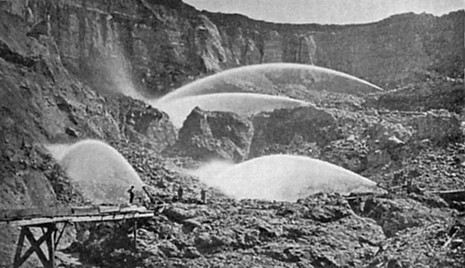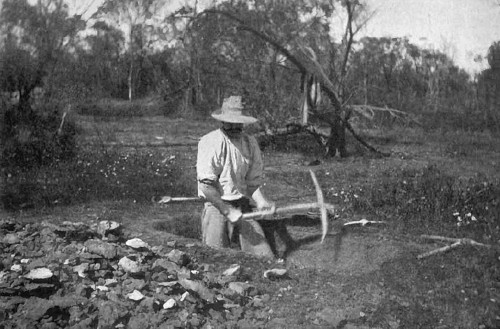Crystalline rocks are made up of certain distinct minerals, most of them of quartz, feldspar and mica with sometimes also hornblende and augite. Other minerals may locally occur as occasional elements.
QUARTZ scarcely
needs description being so well known. The hexagonal prism of this crystal
is too hard to be scratched with a knife and will scratch glass. This
distinguishes it from fluorspar and barite, for which it might be mistaken
in the field, moreover it will not effervesce with acids.
THE FELDSPARS are nearly as hard as
quartz. Their colors are white, greyish and flesh-color. They
are rarely as transparent as quartz, being generally opaque. Their form of
crystallization is different from quartz, and in a vein they show one smooth
face of their crystal, whilst the quartz is more like crushed loaf-sugar. In
a porphyry the feldspar crystals are very distinct, and give a
characteristic spotted appearance to the rock. Two varieties of feldspar are
characteristic of the crystalline rocks, one called orthoclase or common
feldspar, a potash-feldspar, the other called oligoclase, a
soda-lime-feldspar. The former is very characteristic of granitic rocks as
well as of igneous porphyries, the latter is rather more characteristic of
more recently erupted igneous rocks, such as diorite, basalt, andesite, etc.
Orthoclase is generally in large crystals, oligoclase in small. When the
crystals are very small, it may take a microscopic examination to determine
to which variety of feldspars they may belong. The oligoclase and
plagioclase crystals in igneous rocks are commonly but little white dots. To
determine accurately, microscopic slides and chemical tests must be made,
but this is scarcely within the scope of the prospector who wants to guess
roughly at sight as to the name and character of a rock.
MICA, both black
and white, needs no description.
HORNBLENDE differs from mica in being of a duller luster and of a
different form of crystallization as shown in the plate. The color is a
greenish-black; the greenish tint is distinct, when the crystal is struck by
a hammer.
AUGITE or PYROXENE is scarcely distinguishable from hornblende. In
Colorado, augite is mainly confined to two kinds of rock, basalt or dolerite
and andesite, both of comparatively recent volcanic origin. Hornblende and
mica are common to nearly all the metamorphic and igneous rocks.
TALC amongst miners means almost any soft, sticky, or slippery,
decomposed rock, but strictly, talc is a, pale green, soft mineral like mica
and is a silicate of magnesia, teatite or soapstone is massive talc. Miners
often wrongly call any soft clay or rock, soapstone also.
CHLORITE is another magnesian mineral, of a green and soft character.
Chlorite is again a name given to almost any greenish rock of a schistose
and soft decomposed character.
CALCITE is carbonate of lime crystal, the element of limestone,
calcite is distinguished by softness and effervescing in acids.
DOLOMITE or carbonate of lime and magnesia is very like calcite and is
the element of dolomitic or magnesian limestone. Dolomite effervesces with
much greater difficulty than true limestone. To effervesce, the dolomite
should be powdered, and the acid heated.
GYPSUM or sulfate of lime can be distinguished by its extreme
softness, being scratched by the finger nail;
gypsum does not effervesce like lime.
BARITE or "heavy spar" occurs in some veins, but not as a constituent
of rocks. It looks like fluorspar, but
barite is heavier and will not effervesce with acids.
FLUORITE occasionally occurs in veins, in cubes or massive.
Fluorite is easily scratched with a knife; its colors are green,
purple, yellow, blue or white.
GARNETS, GREEN EPIDOTE, BLACK TOURMALINE, and other minerals or gems
may occur, but not as important constituents of the rocks.
CRYSTALLINE AND
METAMORPHIC ROCKS:
GRANITE. Beginning with the granitic series of the Archaean age, granite
proper is massive, shapeless, or amorphous and shows no bedding planes or
other signs of former stratification. It is thoroughly crystalline like
lump-sugar. By some it is considered a true igneous rock, one that has been
thoroughly fused by heat, as much as the lavas or molten iron ; by others
its crystalline amorphous condition is supposed to be the result of extreme
metamorphism of originally sedimentary bedded rocks, such as gneiss or
schist, the two latter being sometimes traced down through a gradual change
into granite. The composition of granite is mica, quartz and feldspar with
sometimes a little hornblende. The micas may be white mica (muscovite), or
black mica (biotite). Both orthoclase and oligoclase feldspar may be
present, but more commonly the former, which is often a pinkish flesh color.
Granite, in its crystalline texture, differs both in character and
appearance from porphyries and other igneous rocks, in the fact that its
crystals are all jumbled up and crushed together like loaf-sugar, and none
of the crystals are set like plums in a pudding, distinctly in a backing or
paste of very small crystals of amorphous or glassy material, as in the
porphyries or igneous rocks. Granite is probably the oldest
and deepest
rock known. It is often traversed by sparry veins, both great and small,
which consists of quartz or feldspar or both, in a more sparry condition
than when diffused through the parent rock. These so-called "quartz veins"
are often called "granulite" or "pegmatite" or "graphic granite." The quartz
and feldspar are often arranged in parallel plates, giving on cross-section
curious marks like Hebrew characters, hence the word graphic.
The bulk of our so-called quartz fissure veins in the granite mountains may be called pegmatitic veins. The colors of granite vary from reddish to gray, or nearly white to black, according to the preponderance and colors of the micas and feldspars in them.
SYENITE is little more
than granite in which hornblende supplies the place of mica.
GNEISS may be called "bedded granite," showing a bedded appearance. Gneiss
is often curiously and prettily banded or streaked by seams of mica
dove-tailing into each other. If mica preponderates, it is called
"mica-gneiss," if hornblende " hornblendic gneiss."
SCHIST may be called laminated-gneiss or laminated-granite, being finally
divided into lamina or leaves. This foliated structure is due to the
arrangement of the flat-lying crystals of mica or hornblende largely
composing it. It may be a mica-schist or a hornblende-schist.
SLATE is shale altered by heat into a hard crystalline structure.
QUARTZITE was originally a sandstone composed of quartz grains, which by
heat have been partially fused together at the edges, resembling granules of
tapioca in a tapioca pudding. Ouartzite differs from quartz in being a rock
made out 01 pieces of quartz, and not the original mineral itself. Quartzite
may be white like sugar, grey, brown, or rusty. It shows a true stratified
structure.
MARBLE is limestone similarly changed to a more crystalline condition.
SERPENTINE is a green magnesian rock, sometimes found with marble and
igneous rocks like peridotite and dunite. It is formed by alteration
of certain minerals in the latter two igneous rocks.
Continue on to:
Study Of Rocks For The Prospector, Part 2
Return To:
Gold And Silver Basic Prospecting Methods


